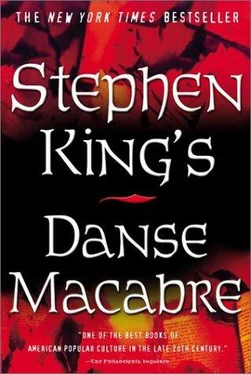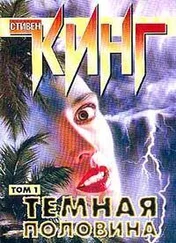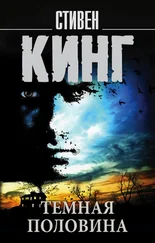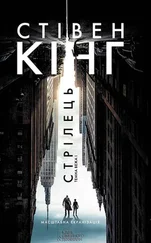10
Los Angeles, 1969. Janis Joplin, who will later die of a drug overdose, it belting out "Ball and Chain." Jim Morrison, who will die of a heart attack in a bathtub, is chanting "Kill, kill, kill, kill" at the end of song titled "The End"-Francis Ford Coppola will use the song ten years later to fade in the prologue of Apocalypse Now. Newsweek publishes a picture of a shyly-smiling U.S.
soldier holding up a revered human ear. And in a Los Angeles suburb, a young boy puts out his brother's eyes with his fingers. He was, he explained, only trying to imitate the old Three Stooges two-fingered boinnng! When they do it on TV, the weeping child explains, no one gets hurt.
11
Television's make-believe violence rolled on nevertheless, through the sixties, past Charles Whitman up on the Texas Tower ("There was a rumor/about a tumor," Kinky Friedman and the Texas Jewboys sang gleefully, "nestled at the base of his braiyyyyn . . .") , and what finally killed it and ushered in the Sitcom Seventies was a seemingly unimportant event when compared to the deaths of a President, a Senator, a great civil rights leader. Television execs were finally forced to rethink their position because a young girl ran out of gas in Roxbury.
She had a gas can in her trunk, unfortunately. She got it filled at a gas station, and while walking back to her beached car, she was set upon by a gang of black youths who took her gas can away from her, doused her with the gas, and then-like the woman and her mother trying to drive the demon out of the baby-lit her on fire. Days later she died. The youths were caught, and someone finally asked them the sixty-fourdollar question: Where did you get such a horrible idea?
From TV, came the response. From The ABC Movie of the Week .
Near the end of the sixties, Ed McBain (in reality novelist Evan Hunter) wrote one of his finest 87th Precinct novels of the policeman's lot. It was called Fuzz, and dealt in part with a gang of teenagers who went around dousing winos with gasoline and lighting them up. The film version, which is described by Steven Scheuer in his invaluable tubeside companion Movies on TV as a "scatterbrained comedy," starring Burt Reynolds and Raquel Welch. The biggest yocks in the movie come when several cops on stakeout dress up as nuns and then chase after a suspect, holding their habits up to reveal big, clunky workshoes. Pretty funny, right, gang? A real gut-buster.
McBain's novel isn't a gut-buster. It's grim and almost beautiful. Certainly he has never come any closer to defining exactly what the policeman's lot may be than near the end of the novel when Steve Carella, masquerading as a wino, is lit on fire himself. The producers of the movie apparently saw something between M*A*S*H and Naked City in this, and the misbegotten result is in most respects as forgettable as a Tracy Stallard fastball . . . except that one of Stallard's fastballs went out of Fenway Park to become Roger Maris's record-breaking sixty-first home run. And Fuzz , a poorly executed comedy-drama, effectively ended TV violence.
The message? You are responsible. And network TV accepted the message.
12
"How do you justify the violence of the shower scene in Psycho?" A critic once asked Sir Alfred Hitchcock.
"How do you Justify the opening scene in Hiroshima, Mon Amour?" Hitchcock is reputed to have replied. In that opening scene, which was certainly scandalous by American standards in 1959, we see Emmanuele Riva and Eliji Okada in a naked embrace.
"The opening scene was necessary to the integrity of the film," the critic answered.
"So was the shower scene in Psycho," Hitchcock said .
13
What sort of burden does the writer-particularly the writer of horror fiction-have to bear in all of this? Certainly there has never been a writer in the field (with the possible exception of Shirley Jackson) who has not been regarded with more than a degree of critical caution. The morality of horror fiction has been called into question for a hundred years. One of the blood-spattered forerunners of Dracula , Varney the Vampyre , was referred to as a "penny dreadful." Later on, inflation turned the penny dreadfuls into dime dreadfuls. In the 1930s there were cries that pulps such as Weird Tales and Spicy Stories (which regularly served up lip-smacking S & M covers on which lovely ladies were tied down, always in their "small clothes," and menaced by some beastly-but identifiably male-creature of the night) were ruining the morals of the youth of America. Similarly in the fifties, the comics industry choked off such outlaw growths as E.C.'s Tales from the Crypt and instituted a Comics Code when it became clear that Congress intended to clean their house for them if they would not clean it for themselves. There would be no more tales of dismemberment, corpses come back from the dead, and premature burials-or at least not for the next ten years. The return was signalled by the unpretentious birth of Creepy , a Warren Group magazine which was a complete throwback to the salad days of Bill Gaines's E.C. horror comics. Uncle Creepy, and his buddy Cousin Eerie, who came along two years or so later, were really interchangeable with the Old Witch and the Crypt-Keeper. Even some of the old artists were back-Joe Orlando, who made his debut as an E.C. artist, was also represented in the premiere issue of Creepy , if memory serves.
I would suggest that there has always been a great tendency, particularly when it comes to such popular forms as movies, television, and mainstream fiction, to kill the messenger for the message. I do not now and never have doubted that the youths who burned the lady in Roxbury got the idea from the telecast of Fuzz one Sunday night on ABC; if it had not been shown, stupidity and lack of imagination might well have reduced them to murdering her in some more mundane way. The same holds true with many of the other cases mentioned here.
The danse macabre is a waltz with death. This is a truth we cannot afford to shy away from.
Like the rides in the amusement park which mimic violent death, the tale of horror is a chance to examine what's going on behind doors which we usually keep double-locked. Yet the human imagination is not content with locked doors. Somewhere there is another dancing partner, the imagination whispers in the night-a partner in a rotting ball gown, a partner with empty eyesockets, green mold growing on her elbow-length gloves, maggots squirming in the thin remains of her hair. To hold such a creature in our arms? Who, you ask me, would be so mad?
Well . . . ?
"You will not want to open this door," Bluebeard tells his wife in that most horrible of all horror stories, "because your husband has forbidden it." But this, of course, only makes her all the more curious . . . . and at last, her curiosity is satisfied.
"You may go anywhere you wish in the castle," Count Dracula tells Jonathan Harker, "except where the doors are locked, where of course you will not wish to go." But Harker goes soon enough.
And so do we all. Perhaps we go to the forbidden door or window willingly because we understand that a time comes when we must go whether we want to or not . . . and not just to look, but to be pushed through. Forever.
14
Baltimore, 1980. The woman is reading a book and waiting for her bus to arrive. The demobbed soldier who approaches her is a Vietnam vet, a sometime dope addict. He has a history of mental problems which seem to date from his period of service. The woman has noticed him on the bus before, sometimes weaving, sometimes staggering, sometimes calling loudly and wildly to people who are not there. "That's right, Captain!" she has heard him say.
Читать дальше










